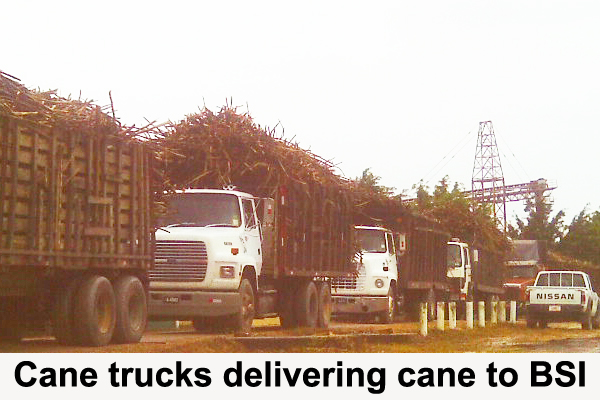Despite intermittent showers and deplorable sugar road surfaces, the sweet smell of sugar permeated the air in Tower Hill this morning as hundreds of sugar cane farmers, primarily from the San Narciso branch in Corozal, covered the entranceway to the factory with their cane trucks, which were loaded with freshly harvested sugar cane stalks – ready to be milled.
After being deferred for eight weeks for various reasons – including persistent rains and a bagasse dispute to which there had been no resolution since late last October – the 2013/2014 sugar cane crop season finally got underway at 10:00 a.m. today.
It was a bittersweet moment for the cañeros, who told us that although they are glad to get the mounting yields of crop ‘off their back’, many of them must also endure unimaginable road conditions in order to get their product delivered to the factory.
According to the Vice Chairman of the Committee of Management of the Belize Sugar Cane Farmers Association (BSCFA), Alfredo Ortega, the cane quality that is being brought to the factory is quite satisfactory, however most farmers are still having issues with the sugar roads which – for the most part –are still in a state of disrepair. He explained, “Today is the start of the new 2013/2014 crop season, and the Corozal division will be delivering during the day period, starting with the San Narciso branch. I must say that we are very proud of the quality of cane that is being brought to the factory today. We decided that –because of the weather that we have been experiencing for the past four days – we will be starting in a controlled system whereby we will continue with a delivery-by-appointment system and the branch from San Narciso was selected as the first to deliver their crop, but I don’t expect that we will be meeting the quota for today because we started experiencing rain from early yesterday morning.”
Jose Novelo, Chairman of the Sugar Cane Production Committee, stated, however, that in his opinion, the cane season got off on a pleasant note, and that, in addition to being impressed by the cane quality, he remains optimistic that the farmers will meet the expected yearly quota. He said, “I am impressed with the quality of the cane that is coming from the cane fields. The cane is very clean despite the fact that it has been raining. To me, it’s a demonstration that the farmers are conscious about maintain[ing] good [cane] quality and that is very good for the industry. It speaks very well for the farmers.”
The initial target for this season was to have 1.2 million tonnes of sugar produced. Some stakeholders in the industry are hopeful that it is still possible to meet that quota, while others are accepting the reality that there will be millions of dollars in cane which are at risk of being wasted.
In response to those concerns, Novelo said, “I would want to think that if the mill can grind more than 7,500 tons a day, and if the farmers are able to meet their daily quotas, then we will surpass the 1.2 million, so I am optimistic that we will be able to do at least a million tonnes; and if weather permits towards the end of May and June, we will indeed be able to mill the 1.2 million tones.”
Although they were wary that time is not on their side and that the quota to be delivered to the factory will more than likely not be met, the cañeros that we spoke to were still happy that they are able to harvest their cane so that they can begin to fulfill their obligations at financial institutions.
Financial loss to both the factory and the farmers are inevitable, though, as there are only an estimated one hundred and fifteen days left to deliver cane to the factory, which has a milling capacity of 7,500 tons per day.
Estimates are that over 10 million dollars in production has been lost, and 16 million dollars more in sugar cane stands to be wasted by the end of this season.

